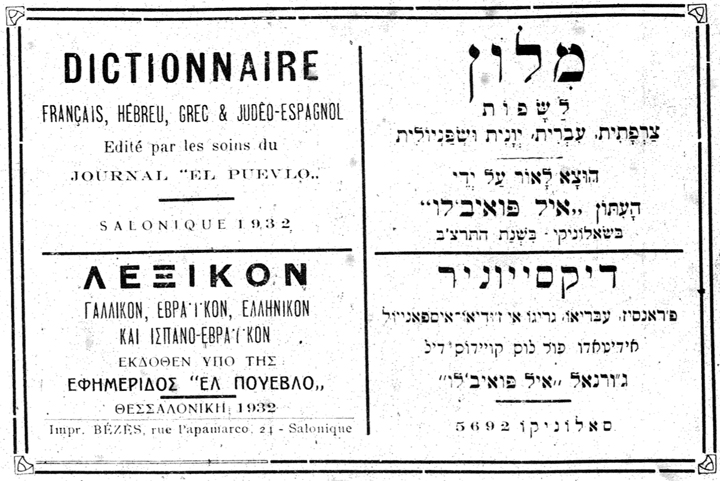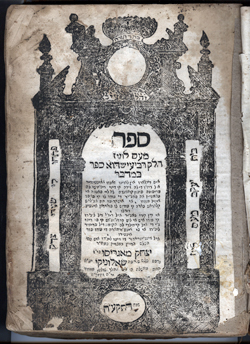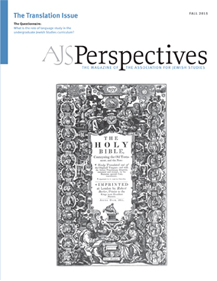Let those who say our language is impoverished eat crap [literally halva]. Is there a language richer than ours, which borrows from every possible language? To tell someone "Be quiet!"— in how many languages do we tell it to him?: Shetika!, Silans!, Mudera!, Kurto!, Sopa!, Molche!, Pyedrelomos!, Sus! (La Aksyon, December 5, 1938)

A standard designation for the language in American English, as adopted by the Library of Congress, the term "Ladino" refers to the process of translation itself, to the act of bridging cultural codes or sets of verbal signs. Ladino stems from the verb, enladinar, which means to render into a Latin-based language—that is, Judeo-Spanish—as opposed to the sacred tongue, Hebrew. The first texts rendered into Ladino, such as the Bible, in the sixteenth century, included word-forword, or calque, translations from Hebrew. The most famous work of Ladino literature began to be published in 1730: the Me-'am lo'ez, a Hebrew-titled series of rabbinical commentaries that made traditional Jewish teachings accessible to the Ottoman Jewish masses, including women, in a language they could more readily understand. The author of the first volume, Jacob Khuli, explained his process: "All the words of this book are translated from the Gemara and midrash. So that whatever is [written] there in the sacred tongue [Hebrew], I translated into a European language [Ladino]."

![“Conversational phrases in Ladino, English, English transliterated into rashi script, and Yuddish” [sic] from Livro de Embezar (New York, 1916), Ladino-English-Yiddish guidebook for Sephardic Jewish immigrants in America. Courtesy of the Sephardic Studies collection, University of Washington.](http://perspectives.ajsnet.org/wp-content/uploads/Livro-de-Embezar2.jpg)
The introduction of Western cultural and ideological trends into the Ottoman Jewish world also brought a critique of the status and value of Judeo-Spanish. Anxieties no longer emerged because it appeared to be a "foreign tongue," the issue that had preoccupied the author of the Me-'am lo'ez, but now in an era of modern, purist nationalisms, because it came to be construed as something less than a language—a bastard tongue unworthy of literary creation. European and American observers disparaged not only this bastard tongue but also orientalized and diminished the entire culture of Sephardic Jews in the Ottoman Empire: "In the 'old country' they had no cultural life of their own worth speaking of. They had no common body of customs and traditions, no common literature, no knowledge of or curiosity about their past . . . They had been a back-ward people in a backward country . . ." (The Forward, July 25, 1926).
![“Method how to learn to read and write in Spanish-Hebrew or in English” [sic] from Livro de Embezar (New York, 1916), Ladino-English-Yiddish guidebook for Sephardic Jewish immigrants in America. Courtesy of the Sephardic Studies collection, University of Washington.](http://perspectives.ajsnet.org/wp-content/uploads/Livro-de-Embezar.jpg)
Others defended their lingua madre, such as the author with whom we began, who viewed the multiple linguistic elements comprising his Judeo-Spanish as a source of strength. They sometimes referred to Judezmo or Djudyo, terms that identified the language as specifically Jewish. The Ottoman authorities agreed with this characterization by referring to Judeo-Spanish, not Hebrew, as Yahudice (Jewish). The perception of the language as distinctly Jewish also resulted in humorous situations. When Argentine film arrived in the Balkans, those Jews who flocked to the cinema believed that they were viewing "Jewish" films because all of the actors appeared to speak "Jewish"—no subtitles were needed.
Pro-Judezmo activists, who eschewed nationalisms and embraced a cosmopolitan perspective, saw the hybridity of Judeo-Spanish as endowing its speakers with ready-made connections to their neighbors that formed the building blocks of intercommunal cooperation. In places like Salonica, home to the largest Judeo-Spanish-speaking community, Jewish socialists promoted Judeo-Spanish as the language of the Jewish proletariat and designated it as the official language of social and economic discourse for the Socialist Workers' Federation. Other activists, like journalist Sam Lévy, argued that those fluent in Judeo-Spanish were already on their way to understanding Turkish, Greek, Bulgarian, French, Italian, etc. This kind of empowering message emphasized that Judeo- Spanish possessed the capacity to translate the foreign into the domestic, to transform its speakers from outsiders to insiders in a variety of contexts. Translation became a process of building cultural bridges that contributed to the creation of a legitimate literature in Judeo-Spanish, including an array of original works. To further facilitate these linkages, Judeo-Spanish promoters created a number of multilingual dictionaries and began assembling a major Ladino library at the Hebrew University in Jerusalem in order to elevate the prestige of their language.
Mass migrations, assimilation, and ultimately, the destruction of the Holocaust, contributed to the dissolution of the Judeo- Spanish cultural world during the twentieth century. Now, in the twenty-first century, we have entered a third phase in Judeo- Spanish translation. From the sixteenth to the eighteenth centuries, authors rendered Hebrew sources into Judeo-Spanish, even if they initially perceived the latter as a "foreign tongue." From the nineteenth into the twentieth centuries, a second phase of translation involved bringing modern European cultural trends into the Judeo- Spanish milieu that also introduced a new anxiety about the target language: that it was not a language at all, but rather a bastard tongue to be abandoned. Still others viewed it as a worthy vehicle for literary production and for building intercultural bridges. Now, in the twenty-first century, most of the estimated five to six thousand Judeo-Spanish publications remain unknown and inaccessible. While a few new translations of classics into Judeo-Spanish continue (The Little Prince, 2010; The Odyssey, 2012), a third phase now involves a move in the opposite direction: out of Judeo-Spanish into more accessible languages, such as English. A flurry of recent initiatives have borne fruit: a translation of the first known Judeo-Spanish memoir; Sephardi Lives, a documentary history comprised of translations of 150 sources from Ladino (and a dozen other languages); and online projects, such as the Sephardi Studies Project at Stanford, which offers translations of key Judeo-Spanish texts; and the University of Washington's new Sephardic Studies Digital Library and Museum, which offers digital versions of Judeo-Spanish sources along with annotations and anticipated translations. These endeavors seek to make Judeo-Spanish source materials accessible, in the original and in translation, for students and scholars, specialists and community members, in order to spark awareness of and interest in the Ladino cultural world and the multiplicities of Jewish experiences. One who asserts that Judeo-Spanish constitutes an impoverished language lacking literature may finally be told: Shetika! Silans! Mudera! Kurto! Sopa! Molche! Pyedrelomos! Sus!

